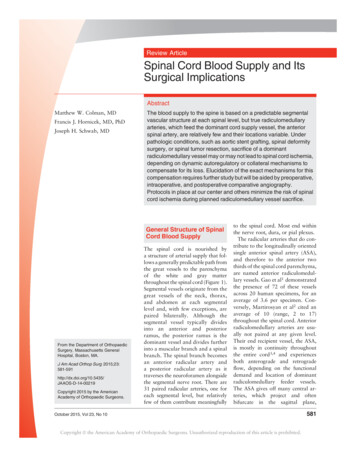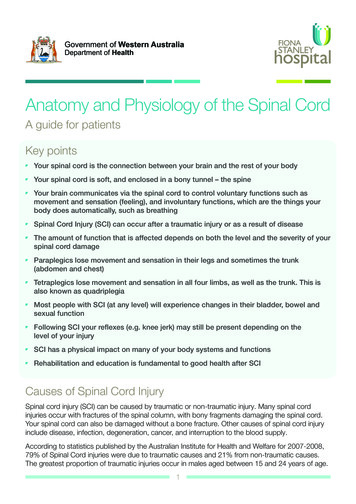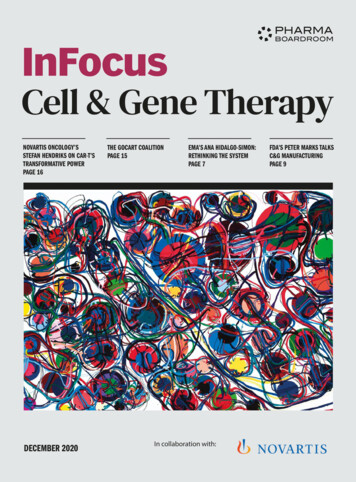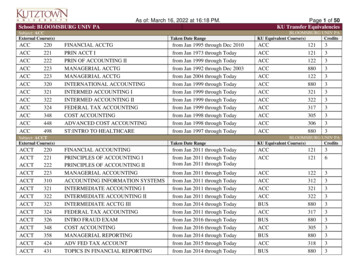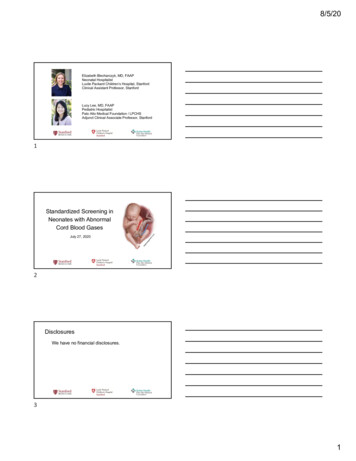
Transcription
Spinal cord injury guidelinesThese guidelines have been developed for assessors, rehabilitation service providers and ACC staff,who work with clients who have a significant impairment due to a traumatic injury to the spinalcord.Guidelines introductionThe Guidelines aim to increase assessors’ and rehabilitation service providers’ understanding of thetypical range of supports needed by people with different levels of spinal cord injury.Assessors can cross-reference their advice about levels of attendant care, against the typical range ofresponses for people with the same level of injury recommended in these Guidelines. This processwill also help assessors justify any levels of proposed attendant care that are above or below thelevels recommended in the Guidelines.The Guidelines will help ACC staff and their clients make objective and consistent decisions aboutthe supports needed to enable clients to participate in everyday life - particularly regarding the levelof attendant care needed.We suggest ACC staff also use the Guidelines to review assessors’ advice and to make decisionsabout the amount of attendant care that will be funded by ACC.The recommendations made in these Guidelines refer to the total number of hours of attendantcare required by the person with that level of injury, regardless of who provides the care. Therecommendations are based on: the level of injury to the person’s spinal cordan assessment of the person’s upper extremity motor function and related motor scoresusing the American Spinal Injury Association (ASIA) Standard Neurological Classification ofSpinal Cord Injuryan assessment of the person’s ability to walk.These Guidelines do not apply to: a child (under 14 years of age) with a spinal cord injurya person whose spinal cord damage has been caused by illness or a congenital conditiona person who has either a pre-existing disability such as epilepsy, or other co-existingimpairments such as a severe brain injury (sometimes referred to as ‘dual diagnosis’ whendetected together) - these make management of their spinal cord injury much morecomplexa person living in institutional or residential care (eg a nursing home).1
DisclaimerThese Guidelines do not intend to set a minimum or maximum standard of care, nor do they makerecommendations about providers of support services.The amount of support recommended in these Guidelines is for a ‘typical’ person with a spinal cordinjury who lives independently (alone or with others) in the community in an appropriately modifiedenvironment.When assessing a person’s support needs, individual circumstances will always need to be taken intoaccount. There are a range of factors that can put a person outside the range typically required bypeople with the same level of injury.An individual’s amount of support may fluctuate. In most cases the change is not permanent and thesupport can return to the ‘typical’ range indicated in these Guidelines. Any request for a change inthe amount of support will be considered by ACC staff, who may ask for a re-assessment if it appearsthere has been a change in need.2
Table of ContentsGuidelines introduction . 1Disclaimer. 2Background to the ACC Spinal injury guidelines . 5Adapting the Guidelines for New Zealand conditions . 6Acknowledgements. 8Workshop 1 members. 8Workshop 2 members. 8Workshop 3 members. 8Structure of these guidelines . 9Assessor instructions for using these guidelines . 9ACC staff instructions for using these guidelines. 9Assessor advice for hours within guidelines . 10Assessor advice for hours outside guidelines . 10Definitions . 11Active nights . 11ASIA impairment scale . 11Attendant care . 12Autonomic dysfunction . 13Autonomic dysreflexia . 13Complete versus Incomplete spinal cord injury . 13Central cord syndrome . 13Anterior cord syndrome . 13Posterior cord syndrome . 13Brown-Sequard syndrome . 13Cauda equina lesion . 14Child-care services . 14Community access . 14Educational support . 14Functional Independence Measure (FIM). 14Functional Assessment Measure (FAM) . 14Home help . 14Home nursing . 15Level of injury or level of lesion . 153
Motor function . 15Neurological level. 16Orthostatic hypotension . 16Paraplegia and tetraplegia . 16Respite care. 16Sensory function . 16Sleepover . 16Supervision . 16Vocational support . 17Factors that affect attendant care . 18Factors that may reduce the amount of attendant care . 18Factors that may increase the amount of attendant care . 18Recommendations for attendant care. 20The different spinal cord injury classifications . 20C1-C3 ASIA A or B recommendations . 21C1-C5 ASIA C recommendations . 24C1-C5 ASIA D recommendations . 27C4 ASIA A or B recommendations . 29C5 ASIA A or B recommendations . 32C6 ASIA A or B recommendations . 35C6-C8 ASIA C recommendations . 38C6-C8 ASIA D recommendations . 41C7-C8 Asia A or B recommendations . 43T1-T6 ASIA A or B recommendations . 46T1-T10, L1 ASIA C recommendations . 48T1-T10, L1 ASIA D recommendations. 50T7-T10, L1 ASIA A or B recommendations . 52L2-L5, S1-S5 ASIA A or B recommendations. 54L2-L5, S1-S5 ASIA C recommendations . 56L2-L5, S1-S5 ASIA D recommendations . 584
Background to the ACC Spinal injury guidelinesThe New Zealand Accident Compensation Scheme provides lifelong support for people who havehad a traumatic injury to their brain or spinal cord (or both), multiple amputations, serious burns orblindness. Coverage under the Scheme is provided regardless of fault.In 2002 the New South Wales Motor Accidents Authority (MAA) released Guidelines for levels ofattendant care for people who have a spinal cord injury. The MAA Guidelines have been used withinthe New South Wales Motor Accidents Scheme to determine care levels for people with a spinalcord injury living in the community. Since then, the 2002 version has been revised and supersededby the 2007 version.ACC obtained permission to use the MAA 2007 Guidelines on a temporary basis, while an expertinformant group adapted the contents for New Zealand conditions.Note:The MAA Guidelines had been adapted from Outcomes following traumatic spinal cord injury:clinical practice guidelines for healthcare professionals, an American guide developed in 1999 by amultidisciplinary expert panel funded by Paralyzed Veterans of America. In May 2006 ACC verifiedthat these guidelines were developed following a robust and valid process, using an Appraisal ofguidelines for research and evaluation (AGREE) instrument.5
Adapting the Guidelines for New Zealand conditionsACC convened a group of expert informants, comprising representatives from a range oforganisations with wide experience in assessing the needs of people with a spinal cord injury.The purpose of the expert informants group was to review the MAA Guidelines, and use a consensusmodel to: recommend to ACC whether the MAA Guidelines are applicable to people with spinal cordinjuries in New Zealandspecify to ACC any changes which would be required of the MAA Guidelines to enable themto be applicable to people with spinal cord injuries in New Zealand.Three workshops were run between 16 December 2007 and 17 March 2008. In the first workshopthe expert informant group reviewed the content relating to complete spinal cord injuries.In the second workshop a sub-committee of the expert group revised content relating to incompletespinal cord injuries.The sub-committee considered that a better option for defining incomplete spinal cord injuries inthe New Zealand environment would be to use the American Spinal Injury Association (ASIA)Standard Neurological Classification of Spinal Cord Injury, and the Functional Independence Measure(FIM) and Functional Assessment Measure (FAM) findings from the Serious Injury Support NeedsAssessment.This would mean the Upper Limb Motor Score (ULMS) utilised in the MAA guidelines would not beused and the potential categories of incomplete spinal cord injury would reduce from the 24 listed inthe MAA Guidelines to eight new categories.It was considered that the ULMS tool did not necessarily translate well to actual functionalindependence in activities of daily living and the associated support needs required.The sub-committee recommended a matrix as illustrated below to categorise incomplete spinal cordinjury.Level of lesionASIA scoreC1-5C6-8T1-L1L2-S5BRefer to complete ASIA ARefer to complete ASIA ARefer to complete ASIA ARefer to complete ASIA ACNew CategoryNew CategoryNew CategoryNew Category6
DNew CategoryNew CategoryNew CategoryNew CategoryFor each of the new categories listed in the matrix above, relevant content was created on Abilities& Assistance Typically Needed and Levels of Human Support. The sub-committee’srecommendations were subsequently endorsed by the full expert informant group.In the third workshop a sub-committee of the expert informants group developed equipment listsfor all types of complete and incomplete spinal cord injury. These have been published in a separatedocument, as the purpose of these Guidelines was recommendations about attendant care.The expert informant group made its full recommendations to ACC on 31 March 2008. The majorityof the expert informant group’s recommendations have been adopted for this publication (the onlyrecommendations not adopted were those which were inconsistent with ACC’s operational policies).Note:The sub-committee would like to acknowledge the immense work the Australian team hadundertaken in providing Guidelines for this very complex area of spinal cord injury management.7
AcknowledgementsACC extends thanks to the expert informant group for their assistance in adapting the NSW MotorAccidents Authority Guidelines for New Zealand conditions. The work of Jo Hinds-Brown inindependently facilitating the work of the expert informant group and the various sub-committees isgratefully acknowledged.Workshop 1 members Marianne Cox, Occupational Therapist and Operations Manager, Auckland Spinal Unit Jonathan Kwan, Physiotherapist and Section Head, Auckland Spinal Unit Maria Low, Clinical Nurse Specialist, Burwood Spinal Unit Viv Mulgrew, Speech Language Therapist, Burwood Spinal Unit Xianghu Xiong, Director and Spinal Consultant, Burwood Spinal Unit Andrew Hall, Chief Executive New Zealand Spinal Trust Cecelia Elderkamp, Community Occupational Therapist, Hawkes Bay Thomas Callagher, The Association for Spinal Concerns (TASC) Representative, Auckland Corrie Pascoe, Occupational Therapist, Senior Support Co-ordinator, ACC National SeriousInjury Service Janice McIntyre, Occupational Therapist, Programme Manager Rehabilitation ServiceDelivery Unit, ACC Corporate Office Sandie Waddell, Manager Customer Access, ACC Corporate Office.Apologies were received from Tracey Emmerson, Community Registered Nurse, Wellington.Workshop 2 members Marianne Cox, Occupational Therapist and Operations Manager, Auckland Spinal Unit Jonathan Kwan, Physiotherapist and Section Head, Auckland Spinal Unit Maria Low, Clinical Nurse Specialist, Burwood Spinal Unit Andrew Hall, Chief Executive New Zealand Spinal Trust Cecelia Elderkamp, Community Occupational Therapist, Hawkes Bay Corrie Pascoe, Occupational Therapist, Senior Support Co-ordinator, ACC National SeriousInjury Service Janice McIntyre, Occupational Therapist, Programme Manager Rehabilitation ServiceDelivery Unit, ACC Corporate Office Tracey Emmerson, Community Registered Nurse, Wellington.Apologies were received from Xianghu Xiong, Director and Spinal Consultant, Burwood Spinal Unit.Workshop 3 members Jonathan Kwan, Physiotherapist and Section Head, Auckland Spinal Unit Cecelia Elderkamp, Community Occupational Therapist, Hawkes Bay Xianghu Xiong, Director and Spinal Consultant, Burwood Spinal Unit.8
Structure of these guidelinesThere are sixteen sets of recommendations corresponding to different types of spinal cord injury,determined by the level of lesion and the score on the ASIA impairment scale.The recommendations for each type of spinal cord injury includes a brief description of abilities andtypes of assistance that are typically required, followed by recommended total hours of humansupport that are typically needed.Assessor instructions for using these guidelinesAssessors must use the Serious Injury Support Needs Assessment form (ACC4202), which containsthe FIM/FAM tools for determining the support needs of people with a spinal cord injury.Assessors should use the findings of their assessment to back up their professional advice about theamount (total number of hours) of attendant care likely to be needed by the injured person.Assessors should pay particular attention to the definitions in these Guidelines for: Level 1 and Level 2 attendant careSupervisionActive nightsSleepover careIf Level 2 attendant care is advised, then this will need to be corroborated by the informationprovided in the FIM or FAM Score of 5 or Less section and the Medical Support Needs section on theSupport Needs Assessment form ACC4202.Assessors’ advice about the total number of hours of attendant care should be cross-referencedagainst the recommendations in these Guidelines (‘Section 2: Client Circumstances’ of the SupportNeeds Assessment form provides the relevant level of lesion and ASIA score information). Thecalculation of FIM/FAM scores should be double-checked for errors if the assessor’s view of theamount of attendant care needed falls outside those recommended by these Guidelines.Assessors who propose attendant care hours above or below the levels recommended in theseGuidelines must provide information in the Individual Home Support & Like Services section of theirSupport Needs Assessment that provide the reasons why an exceptional response is required. Theinformation must include: evidence about the person’s individual circumstances that makes their needs for attendanthours different to a typical person with the same level of injuryevidence of what other alternatives to attendant care have been considered, and for whatreasons those alternatives have been discounted.ACC staff instructions for using these guidelinesBefore their first meeting with the client, Support and Service Coordinators need to access theclient’s medical notes for the level of lesion and ASIA score information, and then review therelevant section of the Guidelines to familiarise themselves with the nature of their client’s injury.9
The client’s first Support Needs Assessment needs to be completed as part of planning for dischargefrom the spinal unit or rehabilitation facility. Support and Service Coordinators need to carefullyreview the advice given in the assessment against the recommended number of hours of supportgiven in these Guidelines. Support and Service Coordinators should pay particular attention to thedefinitions in these Guidelines for: SupervisionActive nightsSleepover care.These Guidelines do not have recommendations for hours of supervision as these are incorporatedinto the recommended hours for attendant care. The recommendations for the total number ofhours of attendant care are given without specific reference to whether this care is at Level 1 orLevel 2.A high proportion of Level 2 attendant care is to be expected for clients with spinal cord injuries atC1-C3, but would be exceptional for clients with an injury at C4 and below.Any advice that Level 2 attendant care is needed should be cross-checked with the evidence that theassessor has provided in the FIM or FAM Score of 5 or Less section and the Medical Support Needssection on the Support Needs Assessment form (ACC4202).When reviewing provider options for Level 2 attendant care, bear in mind that if family members arebeing considered they will need extensive additional training before they start providing attendantcare, and they will require on-going supervision to ensure Level 2 standards of care are beingprovided consistently and reliably.Assessor advice for hours within guidelinesIf the proposed hours of attendant care are within the parameters set out in the Guidelines, thenmove directly onto researching provider options for discussion with the client and theirpartner/family supporters.Assessor advice for hours outside guidelinesIf the proposed hours of attendant care are outside the parameters set out in these Guidelines,check the reasons why an exceptional response is required (refer to the ‘Individual Home Support &Like Services’ section on the Support Needs Assessment form). If the reasons are absent orinsufficient, phone the assessor to obtain it. No additional fees will be paid to the assessor for this.Make sure the reasons justifying an exceptional response are properly documented and attached tothe assessment for future reference.Adapted (with permission) for New Zealand conditions from the NSW Motor Accidents Authority2007 publication Guidelines for Levels of Attendant Care for People with Spinal Cord Injury.10
DefinitionsActive nightsThis refers to the continuous or regular attention by an attendant care worker to perform such tasksas ventilator management or tracheal suctioning throughout the night. The attendant care workermust be awake throughout the night.Active night care is definitely required on a permanent basis by people with a lesion at C1-C3 and anASIA score of A. This requirement has been built into the guideline’s recommended total hours forattendant care.At other levels of lesion, active night care may be required but only in exceptional circumstances.Such circumstances could include people suffering a temporary health crisis such as a severe chestinfection or receiving treatment for major medical conditions such as cancer.ASIA impairment scaleThe American Spinal Injury Association (ASIA) Standard Neurological Classification of Spinal CordInjury is a standard method of assessing the neurological status of a person who has sustained aspinal cord injury. ASIA scale assessments are usually carried out by specialist medical staff at thehospital the person is admitted to.ASIA international standards for neurological classification of spinal cord injury worksheet (PDF 579KB)It is important to include the score on the ASIA impairment scale in the referral for a spinal injuredclient. This score can usually be found in the medical notes of a client who has been admitted intoeither of the spinal units.The ASIA impairment scale has five categories as follows:CategoryDefinitionA CompleteNo motor or sensory function is preserved in the sacral segments S4-S5A CompleteNo motor or sensory function is preserved in the sacral segments S4-S5B IncompleteSensory but not motor function is preserved below the neurological level and includesthe sacral segments S4-S5C IncompleteMotor function is preserved below the neurological level, and more than half of keymuscles below the neurological level have a muscle grade of less than 3D IncompleteMotor function is preserved below the neurological level, and at least half of the keymuscles below the neurological level have a muscle grade of 3 or more11
E NormalMotor and sensory function are normal.Attendant careAttendant care is a technical term that describes the support that a person with a spinal cord injuryneeds, in order to do tasks they would have been doing for themselves prior to their accident.The legislation that ACC operates under (the Accident Compensation Act 2001) defines attendantcare as: personal care (physical assistance to move around and to take care of basic personal needssuch as bathing, dressing, feeding, and toileting)assistance with cognitive tasks of daily living such as communication, orientation, planning,and task completionprotection of the person from further injury in his or her ordinary environmentattendant care does not include child care, domestic activities, or home maintenance.ACC distinguishes between two types of attendant care, according to the client’s level of medicaland behavioural needs. Level 1 attendant care is what people with a spinal cord injury will typicallyrequire in most circumstances. Level 1 attendant care includes: assistance with undressing and dressing, transferring into and out of the bath or shower,washing and drying, hair washing and monitoring the condition of skin/scalpassistance with personal grooming activities, hair maintenance, teeth cleaning, cleaning &trimming finger/toe nailsassistance with eating and drinking, observing and monitoring food intake, helping withsticking to special diets, preparing food, ensuring the person is positioned correctly and hasaccess to any specialist utensils neededassistance with transfers to and from the toilet/commode and hygiene activities, assistancewith the use of appliances and aids such as day/night urinary collection bags and associatedhygienetransferring from bed to wheelchair and vice versa, ensuring safe mobility around the homeincluding making sure aids such as walking sticks, frames and wheelchairs are maintainedand safephysically assisting the person’s mobility inside and outside their homecoaching in activities of daily living, in conveying and receiving information and interactingwith other peopledeveloping personal skills such as planning, communication, task completion, andmaintaining emotional controlgiving support to protect the person from further injury in their normal home environment.Level 2 attendant care includes all of the above activities, but due to the injured person’s highmedical or behavioural needs, the complexity of all of these tasks is greatly increased. Theconsequences of performing these tasks incorrectly are usually severe and prolonged for the injuredperson. Therefore, providing Level 2 attendant care requires a level of knowledge and skill that isequivalent to that possessed by a registered nurse.12
Autonomic dysfunctionAutonomic dysfunction (or dysautonomia) is a medical term which means the body’s regulatorysystem is not working. The body’s regulatory system is very complex and controls heart rate, bloodpressure, temperature and the secretion of hormones and digestive enzymes.Autonomic dysreflexiaAutonomic dysreflexia is a medical term that refers specifically to problems with a person’s bloodpressure. It is very common amongst people with a spinal cord injury.It refers to a condition where the person’s blood pressure spikes to dangerous levels, risking strokeor possibly death if untreated. It is usually triggered by something like a bladder infection, whichpeople with spinal cord injuries are often unaware that they have. People with spinal cord injury atthe T6 level or above are at greater risk.Complete versus Incomplete spinal cord injuryA ‘complete lesion’ or complete spinal cord injury means there are no messages transmitted by thenerves at the level of injury. Clinically it means there is no movement and no sensation below thelevel of injury, and this type of condition is described as ASIA classification A.An incomplete spinal cord injury means there is partial damage and some (or all) feeling andmovement remains below the level of lesion. The amount lost will depend on how much damage isdone to the spinal cord. Individual circumstances will need to be taken into account when assessinga person’s care needs. For example spasticity may severely reduce function and increase the supportrequirements. There are five main types of incomplete injury syndrome.Central cord syndromePeople with central cord syndro
impairments such as a severe brain injury (sometimes referred to as dual diagnosis when detected together) - these make management of their spinal cord injury much more complex a person living in institutional or residential care (eg a nursing home).
